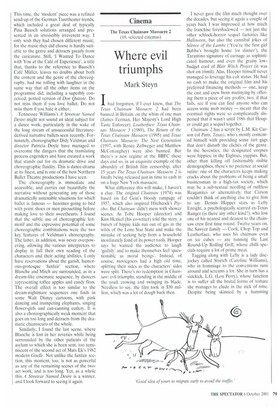Dance
Les Ballets Trockadero de Montecarlo (Peacock Theatre, London WC2) A Streetcar Named Desire (Northern Ballet Theatre, Alhambra Theatre, Bradford)
Irresistibly irreverent
thannandrea Poesio
B..11et, with its allegedly inaccessible vocabulary, its idiosyncratic mannerisms and its often preposterous narratives, has long been the object of parody and caricature. In the 20th century alone the list of those who have had a go at it is surprisingly long and star-studded: it includes, among others, Charlie Chaplin, Danny Kaye, Fred Astaire, Nancy Walker, Barbra Streisand, Dawn French, Jennifer Saunders and, in the world of cartoons, Mickey Mouse, Bugs Bunny and the unforgettable hippos and elephants of Disney's Dance of the Hours.
Yet only the members (all male) of the now legendary Les Ballets Trockadero de Montecarlo — a name that is an exquisite parody in itself — know how to send up ballet by going beyond the more obvious and somehow predictable aspects of that art form. Their parody, in other words, relies on and stems from a truly deep knowledge of ballet, and more in particular of its history, its performers and the variety of its stylistic nuances. This is why, despite all the jokes, the antics and even the various carefully administered slapstick routines, they are rightly considered one of the most interesting groups in contemporary ballet, and are paid the same respect as other, more standard dance companies.
Their performances are always a compendium of amazing bravura and comic talent. The first of the two programmes they presented this season at the Peacock Theatre also revealed how the Trocks are always striving to update their repertoire by adding new, even contemporary items to it. This time, the 'modern' piece was a refined send-up of the German Tanztheater trends, which included a great deal of typically Pina Bausch solutions arranged and presented in an irresistibly irreverent way. I only wish they had chosen different music, for the music they did choose is hardly suitable to the genre and detracts greatly from the caricature. Still. 'I Wanted To Dance with You at the Café of Experience', a title that, thanks to the reference to Bausch's Café Muller, leaves no doubts about both the content and the genre of the choreography, had me rolling with laughter in the same way that all the other items on the programme did, including a superbly conceived, potted version of Don Quixote. Do not miss them if you love ballet. Do not miss them if you hate it either.
Tennessee Williams's A Streetcar Named Desire might not sound an ideal subject for a dance work, particularly in the wake of the long stream of unsuccessful literaturederived narrative ballets seen recently. Fortunately, choreographer Didy Veldman and director Patricia Doyle have managed to overcome the dangers that the translating process engenders and have created a work that stands out for its dramatic drive and choreographic fluidity. This is dance-drama at its finest, and is one of the best Northern Ballet Theatre productions I have seen.
The choreography is immediate and accessible, and carries out beautifully the narrative without generating any of those dramatically untenable situations for which ballet is famous — heroines going to bed with point shoes or men pirouetting before making love to their sweethearts. I found that the subtle use of choreographic leitmotif and the expressive potential of some choreographic combinations were the two key features of Veldman's choreography. The latter, in addition, was never overpowering, allowing the various interpreters to display in full their own reading of the characters and their acting abilities. I only have reservations about the garish, humorous-grotesque 'funfair' section, where Blanche and Mitch are surrounded, as in a dream-like cinematic sequence, by dancers representing toffee apples and candy floss. The overall effect is too similar to the dream-nightmare sequences one finds in some Walt Disney cartoons, with pink dancing and trumpeting elephants, singing flower-girls and can-canning cutlery. It is also a choreographically weak moment that goes on too long and detracts from the dramatic chiaroscuro of the whole.
Similarly, I found the last scene, where Blanche is lost in her reveries while being surrounded by the other patients of the asylum to which she is been sent, too reminiscent of the second act of Mats Ek's 1982 modern Giselle. Not unlike the funfair section, this moment, too, is not as powerful as any of the remaining scenes of the twoact work, and is too long. Yet, as a whole this A Streetcar Named Desire is a winner, and I look forward to seeing it again.



































































































 Previous page
Previous page